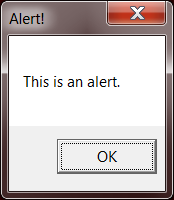Native Message Boxes¶
In addition to displaying message boxes using Python’s built-in TkInter GUI toolkit, PyMsgBox also has limited support for displaying message boxes by calling the operating system’s native functions. These exist in the native module. To use them, call:
>>> import pymsgbox
>>> pymsgbox.native.alert('This is an alert.', 'The title.')
Or, to avoid changing your function calls to use pymsgbox.native, run:
>>> import pymsgbox.native as pymsgbox
Support¶
These are the platforms and functions that have native message box support. Functions that do are not supported will default back to the normal TkInter-based message box.
Support as of v1.0.1:
| Windows | OS X | Linux | JVM / Jython | |
alert() |
Yes | No | No | No |
confirm() |
Yes | No | No | No |
prompt() |
No | No | No | No |
password() |
No | No | No | No |
Special Notes¶
Windows - alert()¶
The message box will only show a button with text “OK”, no matter what is passed for the button argument. The button argument will be the text that is returned by the function, just like the TkInter alert().
>>> pymsgbox.native.alert('This is an alert.', 'Alert!')
'OK'

Windows - confirm()¶
There will only be buttons “OK” and “Cancel”, no matter what is passed for the buttons argument. If “OK” is clicked, the first item in the buttons list is returned (by default, this is 'OK'). If “Cancel” is clicked, the second item in the buttons list is returned (by default, this is 'Cancel'), just like the TkInter confirm().
>>> pymsgbox.native.confirm('Nuke the site from orbit?', 'Confirm nuke', ["Yes, I'm sure.", 'Cancel'])
"Yes, I'm sure."
